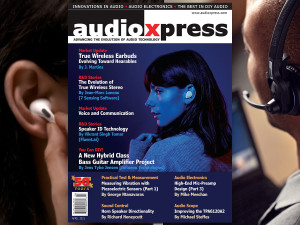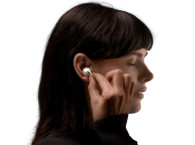 In a dedicated Market Update, audioXpress explores "Unifying Communications with Amplified Intelligence." An article that details the exciting convergence of voice and speech-to-text technologies, now empowered by artificial intelligence and machine learning to enhance audio communications: A crossroads perspective of cutting-edge innovations and opportunities. For this market update report, audioXpress specifically looks at how the evolution in the field of voice capture for voice recognition products is vitalizing communications and specifically Unified Communications & Collaboration (UC&C).
In a dedicated Market Update, audioXpress explores "Unifying Communications with Amplified Intelligence." An article that details the exciting convergence of voice and speech-to-text technologies, now empowered by artificial intelligence and machine learning to enhance audio communications: A crossroads perspective of cutting-edge innovations and opportunities. For this market update report, audioXpress specifically looks at how the evolution in the field of voice capture for voice recognition products is vitalizing communications and specifically Unified Communications & Collaboration (UC&C).As part of its focus on voice convergence, audioXpress is honored to offer a contributed article by Vikrant Singh Tomar (Fluent.ai), describing how increasing consumer demand for personalized experiences has sparked the creation of speaker ID technology, and exploring the challenges that this type of technology still faces. A valuable perspective from a company positioned right at the edge of voice recognition, personalized experiences, voice profiling, and language challenges, implementing low power designs using AI and edge processing.
A second Market Update feature addresses "True Wireless Earbuds Evolving Toward Hearables" - an overview of what is happening in this vibrant product category. In a market that is predicted to continue to grow and surpass other consumer electronic product categories, this article provides an overview of the state-of the-art technologies and platforms, as well as some reference approaches in product design. As both headphones and true wireless earbuds continue to gain augmented audio features, benefiting from the latest advancements in audio processing, active noise cancellation, spatial audio, and other innovations, we will see even more acceleration in building up the basic blocks toward hearables.
Adding a valuable contributed perspective to the topic, Jean-Marc Luneau (7 Sensing Software) writes specifically about "The Evolution of True Wireless Stereo," and some meaningful new features and improvements that can help True Wireless Stereo (TWS) earbud brands differentiate their products and make them stand out in today’s crowded market.
George Ntanavaras starts an exciting Practical Test & Measurement journey to measure vibration using piezoelectric sensors. This will be a three-part series from the author of the popular accelerometer project - a system consisting of the ACH-01 accelerometer and an amplifier with an integrated analog signal processor - used by many audioXpress readers for their evaluations. In this latest exploration, Ntanavaras looks for other possible solutions concerning vibration measurements, describes his research for the design, the construction of such a system, and presents the results and the measurements.
Another exciting option for our readers in search of a DIY audio project, Jens Tybo Jensen (Infineon Technologies) describes a very interesting bass amplifier design. Titled "An Old-Fashioned Tube Amp and Multilevel Class-D Hybrid DIY Bass Guitar Amplifier Project," it combines the Infineon MERUS MA12070 IC and demonstration board, to create a novel approach to hybrid amplifiers - a tube bass amplifier that can even be battery-powered. The project offers all the highly regarded characteristics of a preamplifier stage, based on a real 12AU7 triode vacuum tube, enhanced by an efficient power stage based on the Infineon multilevel digital audio power amplifier technology, able to deliver up to 60W RMS into a 4Ω loudspeaker load.
On his Sound Control column, Richard Honeycutt, discusses "One Traditional Way to Increase Loudspeaker Directionality," as used in horn speakers. A great deal of research has been done on acoustic horns and much of it has focused on the effect of different flare profiles and rates upon the variation of efficiency with frequency. In this article, Honeycutt discusses how horn designs have evolved to address directionality since their first use in acoustic phonographs.
Mike Meechan serves the third chapter in his exploration of the science and physics of high-end mic-preamp design. At this stage, he considers constructing some of the theoretically perfect building blocks of an active mic preamp. Here he details what is achieved by highly regarded analog designs, such as those by The John Hardy Co., Graeme Cohen, or fully integrated solutions from Analog Devices, Texas Instruments (Burr Brown) and THAT Corp., among others.
 For his Audio Scope column, Michael Steffes writes about improving the input noise model for a high output current dual headphone driver, the TI TPA6120A2. This very popular solution for highly linear audio headphone driver designs can effectively benefit using a TINA simulation model for the earlier THS6012 design, enabling a more accurate prediction of integrated output noise.
For his Audio Scope column, Michael Steffes writes about improving the input noise model for a high output current dual headphone driver, the TI TPA6120A2. This very popular solution for highly linear audio headphone driver designs can effectively benefit using a TINA simulation model for the earlier THS6012 design, enabling a more accurate prediction of integrated output noise.With this latest edition, audioXpress keeps raising the value for the audio industry in general, with great content, published 12 times per year, and available in print and online. Subscribing to the digital online version allows immediate access at: www.audioxpress.com/page/audioXpress-Subscription-Services.html
If you wish to buy a single printed issue or the complete audioXpress archive on USB, from 2000 to 2021 (yes, including the latest issue), just visit our online shop at www.cc-webshop.com
Don't miss out, get your copy of audioXpress right now at www.gotomyxpress.com






